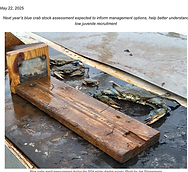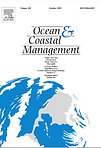Articles


Species in Choptank River, 1990- 2024
-
Atlantic Silverside
-
Atlantic Menhaden
-
White Perch
-
Striped Bass
-
Striped Kill Fish
Maryland Department of Natural Resources Fish Survey Data
Articles featuring Chesapeake Bay Fisheries are provided below.
Maryland Department of Natural Resources

May 22, 2025
Next year’s blue crab stock assessment expected to inform management options, help better understand low juvenile recruitment.
The Chesapeake Bay Blue Crab Winter Dredge Survey, a cooperative effort between the Maryland Department of Natural Resources and the Virginia Institute of Marine Science, estimates 238 million blue crabs in the Chesapeake Bay in 2025, a decrease from last year’s 317 million crabs.The results showed decreases in the abundance of adult male and female crabs, as well as a decline in the juvenile population, marking the sixth consecutive year of below average juvenile recruitment found in the survey.
“We saw a very high mortality rate among blue crabs this winter, likely due to several cold snaps,” said Mandy Bromilow, DNR’s blue crab program manager. “With the results of the stock assessment next year, we hope to have more insight on what could be contributing to the ongoing low juvenile recruitment and what we can do to support the Chesapeake Bay’s blue crabs. Until then, we need to maintain caution in our management approach for blue crabs.”
This year’s total estimated abundance is the second lowest in the history of the survey, which has operated since 1990. The lowest was 226 million crabs in 2022. The juvenile abundance of 103 million in 2025 was a decrease from 138 million last year, and the third lowest abundance on record, after 2021 and 2022.
The estimated number of spawning age female crabs decreased from 133 million in 2024 to 108 million in 2025. The number of adult male crabs decreased from 46 million in 2024 to 26 million in 2025.
The female abundance is above the threshold number of 72.5 million crabs and below the target of 196 million crabs. In fisheries management, target numbers represent the desired state of a fishery, while thresholds are lower numbers that can trigger a management response. Based on the current management framework, the abundance of mature females should be high enough to support a strong juvenile year class given the right environmental conditions.
Blue crab reproduction is naturally variable and influenced by many factors such as oceanic conditions, available nursery habitat, predation, and other environmental impacts. The blue crab harvest is known to follow a boom and bust cycle, with runs of years with higher harvest followed by stretches of lower harvest.
Blue crab management in the Chesapeake Bay will benefit from the completion of the ongoing stock assessment in the spring of 2026. In this analysis, scientists will examine years of data to assess potential factors that could be affecting the blue crab population, including hypoxia, water temperature, habitat availability, and predation by blue catfish.
The previous blue crab stock assessment in 2011 and accompanying management decisions helped to bring the Chesapeake’s blue crab population back from more than a decade of low abundance and harvest levels. The current stock assessment will serve as a critical update to that work by ensuring that management targets and thresholds, including sustainable fishing rates, are set appropriately.
The Winter Dredge Survey has been conducted cooperatively by Maryland and Virginia since 1990, and the results are reviewed annually in an effort to have consistent management efforts across the jurisdictions. Throughout the survey, biologists use dredge equipment to capture, measure, record and release blue crabs at 1,500 sites throughout the Chesapeake Bay from December through March. Detailed results are on the DNR website.
Valuing shoreline habitats for recreational fishing
Andrew M. Scheld a, Donna M. Bilkovic a, Sarah Stafford b, Kathleen Powers c, Susanna Musick a, Amanda G. Guthrie d
a Virginia Institute of Marine Science, William & Mary, Gloucester Point, VA, USA
b Department of Economics, William & Mary, Williamsburg, VA, USA
c University of Virginia, Charlottesville, VA, USA
d South Carolina Sea Grant Consortium, Charleston, SC, USA
Ocean & Coastal Management
Volume 253, 1 July 2024, 107150

Article Excerpt
Shoreline armoring, or hardening, with engineered structures such as riprap revetment, bulkheads, or seawalls, is a common shoreline management practice used to reduce erosion and property loss. Armored shorelines have been found to compromise coastal habitat integrity, ecosystem service delivery, and connectivity however (e.g., Bozek and Burdick 2005; Bilkovic et al., 2006; Bilkovic and Roggero 2008; Dugan et al., 2008; Gittman et al., 2015; Dethier et al., 2016; Dugan et al., 2018). Conversely, nature-based shoreline management practices that involve the protection, restoration, or enhancement of native coastal habitats for erosion control through the placement of plants, stone, sand, and other materials, and do not disrupt natural land-water connections and processes (i.e., living shorelines), can provide multiple secondary ecosystem benefits (Bilkovic et al., 2016). For example, many living shoreline designs include the use of wetland vegetation, which can provide refuge and foraging habitat for fish and crustaceans (Davis et al., 2006; Currin et al., 2008; Scyphers et al., 2011; Gittman et al., 2016; Smith et al., 2021; Guthrie et al., 2022). While barriers to increased utilization of this shoreline management strategy remain (Morris et al., 2022), all coastal US states currently have non-regulatory or regulatory policies that encourage, endorse, or require living shorelines where suitable for erosion control (Mason et al. in prep). Understanding recreational use of coastal habitats, including different shoreline types, can inform estimates of benefits and costs associated with shoreline management policies.
Next year’s blue crab stock assessment expected to inform management options, help better understand low juvenile recruitment.
May 22, 2025

Maryland Department of Natural Resources
The Chesapeake Bay Blue Crab Winter Dredge Survey, a cooperative effort between the Maryland Department of Natural Resources and the Virginia Institute of Marine Science, estimates 238 million blue crabs in the Chesapeake Bay in 2025, a decrease from last year’s 317 million crabs.The results showed decreases in the abundance of adult male and female crabs, as well as a decline in the juvenile population, marking the sixth consecutive year of below average juvenile recruitment found in the survey.
“We saw a very high mortality rate among blue crabs this winter, likely due to several cold snaps,” said Mandy Bromilow, DNR’s blue crab program manager. “With the results of the stock assessment next year, we hope to have more insight on what could be contributing to the ongoing low juvenile recruitment and what we can do to support the Chesapeake Bay’s blue crabs. Until then, we need to maintain caution in our management approach for blue crabs.”
This year’s total estimated abundance is the second lowest in the history of the survey, which has operated since 1990. The lowest was 226 million crabs in 2022. The juvenile abundance of 103 million in 2025 was a decrease from 138 million last year, and the third lowest abundance on record, after 2021 and 2022.
The estimated number of spawning age female crabs decreased from 133 million in 2024 to 108 million in 2025. The number of adult male crabs decreased from 46 million in 2024 to 26 million in 2025.
The female abundance is above the threshold number of 72.5 million crabs and below the target of 196 million crabs. In fisheries management, target numbers represent the desired state of a fishery, while thresholds are lower numbers that can trigger a management response. Based on the current management framework, the abundance of mature females should be high enough to support a strong juvenile year class given the right environmental conditions.
Blue crab reproduction is naturally variable and influenced by many factors such as oceanic conditions, available nursery habitat, predation, and other environmental impacts. The blue crab harvest is known to follow a boom and bust cycle, with runs of years with higher harvest followed by stretches of lower harvest.
Blue crab management in the Chesapeake Bay will benefit from the completion of the ongoing stock assessment in the spring of 2026. In this analysis, scientists will examine years of data to assess potential factors that could be affecting the blue crab population, including hypoxia, water temperature, habitat availability, and predation by blue catfish.
The previous blue crab stock assessment in 2011 and accompanying management decisions helped to bring the Chesapeake’s blue crab population back from more than a decade of low abundance and harvest levels. The current stock assessment will serve as a critical update to that work by ensuring that management targets and thresholds, including sustainable fishing rates, are set appropriately.
The Winter Dredge Survey has been conducted cooperatively by Maryland and Virginia since 1990, and the results are reviewed annually in an effort to have consistent management efforts across the jurisdictions. Throughout the survey, biologists use dredge equipment to capture, measure, record and release blue crabs at 1,500 sites throughout the Chesapeake Bay from December through March. Detailed results are on the DNR website.